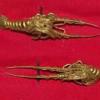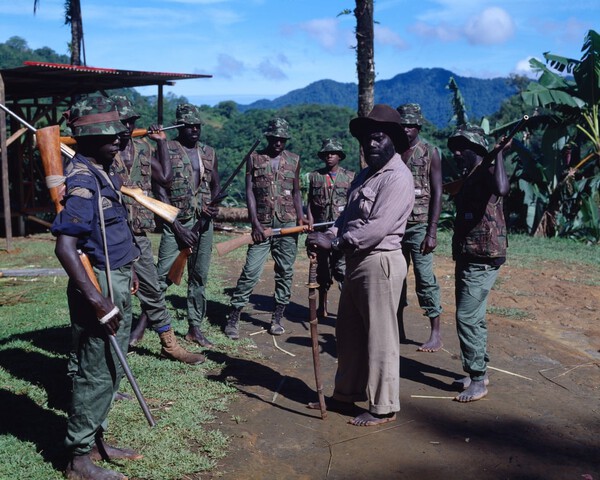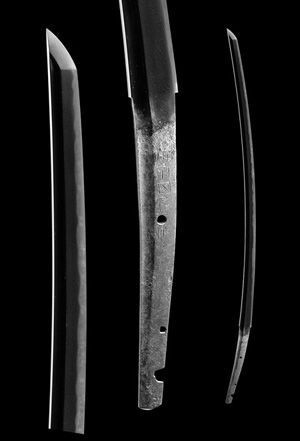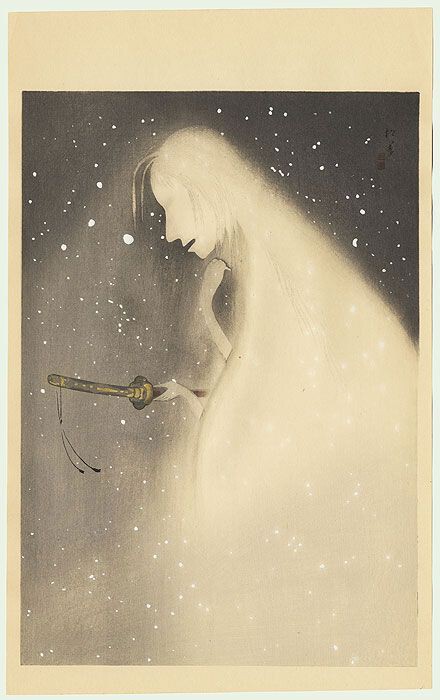-
Posts
435 -
Joined
-
Last visited
Content Type
Profiles
Forums
Events
Store
Downloads
Gallery
Everything posted by Lance
-
I'd like to place a guess (that nobody asked for) as to how this large portion of hada originated, As the sunobe was first drawn out from the billet the smith decides where the nakago and blade start and that point gets the extra hammering (in both directions) creating the stretched larger area of hada. After that the rest of the blade gets drawn out consistently and shaped as usual. As a master smith this quirk became a routine part of his forging regimen,enough to make it a kantei point. Regards, Lance
-

Sharpness of a sword? Auction problem
Lance replied to vajo's topic in General Nihonto Related Discussion
Weird. Im sure the auction and sale would have been more smooth without a strange/picky buyer. Aside from being physically ground down to a dull edge,most Nihonto are sharp, just not straight razor sharp. This reminds me of an iron Nara or Hanmana school tsuba I sold on ebay many years ago, Multiple photos, as described, and the buyer said the one I sent him was different because I described the patina as chocolatey, and it was more of a caramel color (I kid you not) +At least I ended up reselling it for more than the first time but sometimes you get problem buyers, often very strange. A separate thread about unusual finds orthe characters involved might be entertaining. Regards, Lancei -
Aside from Yuki, maybe Nori? Let me see if this works, I copy/pasted link for image from another post from my tablet, Imagine the whole left side of the Nori character deleted by the new hole leaving just the single right vertical stroke? https://m.imgur.com/gallery/YJCI2IU Any chance you have other pics of the blade itelf? Regards, Lance
-
Rather than a surrender document, the letter attributing the sword to Nobukuni looks to be an appraisal signed by Captain Kuroki, not a personal sword surrendered by him. Probably one of the Japanese soldiers tasked with managing surrendered/collected souveneirs to occupying soldiers? Regards, Lance
-
My initial impression is Kinai or cast version, but if there's a surprise twist as Guido suggests I'll play along and be really wacky and say Goto school maker due to the way the clouds are carved on it. Feel free to throw rotten tomatoes. Regards, Lance
-
I'll take a shot and guess number 7, due to the hide charater and mekugi ana placement Regards, Lance
-
Thank you Bryce Regards, Lance
-
Thanks everybody. I had read some articles a few years back about anti poaching efforts in African conservation areas, and the photos in the article had anti poaching units carrying firearms that looked like these same types of simple single shot shotguns. Regards, Lance.
-
Thought I'd share this oddity; Came across this picture, no real info as it was a just a humorous reddit post but appears to be a genuine Kai-gunto in Africa Photo seems to be relatively recent (at least digital age) but camouflage patterns look to be from the 80's? Also added a link to zoom-able version if you want to take a closer look. https://external-preview.redd.it/kGmIvJzMd868zSS0yh3eTL69AYCYwne4xQ-Ycnqx6I8.jpg?auto=webp&s=cd36b8090ca4642fce590cc894606f177ff8cec5 If anybody's seen this photo before or can tell from the plant life and guns they're carrying where this was from I'd love to know more about it (look like locally made shotguns and tropical region, maybe central Africa?) Regards, Lance
-

Obscured / Rusted Mei - How to Read?
Lance replied to tbonesullivan's topic in Translation Assistance
Something similar to the smoke method Yoshimichii mentioned above, use a soft pencil at shallow angle and lightly rub over entire nakago, then apply the clear 2 inch tape over it, lightly rub, remove and place on white paper. After you're done you can just wipe off residue with choji oil. Regards, Lance -
If I remember it right, it's formed in a similar manner to others types, but at a certain point late in the folding process the smith takes a chisel and punches/dimples the block to embed that warped pattern and continues forging the billet, and when drawing out the length of the blade it's from a different side. (something like top and bottom of block becomes the sides and side becomes top and bottom. As Ken mentions similar to how masame is formed) Hopefully if I'm too far off someone will step in to correct me. Regards, Lance
-
Obviously not talking about breaking up daisho fittings or koshirae from blades, but II don't see an issue with a private collection being separated as nobody is really going to have a connection with everything you may have as a whole, unless they were your children, a close friend or relative and becomes a memento of that friendship/familial ties. It would probably be more difficult thinking about everything being dispersed if you collection was comprised of something like examples of different generations of sword smiths, fittings artists from a given school, themes, or every example of gunto. Otherwise wanting the individual pieces to be cared for and enjoyed is probably the best you could hope for. Regards, Lance
-
The sword Ō-Kanehira"seems to have one of these notches (and an additional little pin hole ana) I think the pic below was used for the cover Metropolitan Museum's Arts of the Samurai exhibit catalog. Regards, Lance
-

Tosogu with samurai women / strong women motif
Lance replied to Tigerinbamboo's topic in Wanted to Buy
Below are a couple images of a kozuka with NTHK attribution to Kaga Goto Etsujo depicting, Orihime the weaver maiden working at her loom, a figure from Japan's Tanabata festival. .Tanabata also known as the Star Festival originated in the Chinese Qixi Festival. It celebrates the meeting of the deities Orihime and Hikoboshi (represented by the stars Vega and Altair respectively). According to legend, the Milky Way separates these lovers, and they are allowed to meet only once a year on the seventh day of the seventh lunar month of the lunisolar calendar. The date of Tanabata varies by region of the country, but the first festivities begin on 7 July of the Gregorian calendar. The celebration is held at various days between July and August. Orihime (織姫 Weaving Princess), daughter of the Tentei (天帝 Sky King, or the universe itself), wove beautiful clothes by the bank of the Amanogawa (天の川 Milky Way, literally "heavenly river"). Her father loved the cloth that she wove and so she worked very hard every day to weave it. However, Orihime was sad that because of her hard work she could never meet and fall in love with anyone. Concerned about his daughter, Tentei arranged for her to meet Hikoboshi (彦星 Cowman/Cowherd Star, or literally Boy Star) (also referred to as Kengyū (牽牛)) who lived and worked on the other side of the Amanogawa. When the two met, they fell instantly in love with each other and married shortly thereafter. However, once married, Orihime would no longer weave cloth for Tentei and Hikoboshi allowed his cows to stray all over Heaven. In anger, Tentei separated the two lovers across the Amanogawa and forbade them to meet. Orihime became despondent at the loss of her husband and asked her father to let them meet again. Tentei was moved by his daughter's tears and allowed the two to meet on the 7th day of the 7th month if she worked hard and finished her weaving. The first time they tried to meet, however, they found that they could not cross the river because there was no bridge. Orihime cried so much that a flock of magpies came and promised to make a bridge with their wings so that she could cross the river. It is said that if it rains on Tanabata, the magpies cannot come because of the rise of the river and the two lovers must wait until another year to meet. The rain of this day is called "The tear of Orihime and Hikoboshi". http://www.Japan-suite.com/blog/2014/7/6/tanabata-story-of-two-star-crossed-lovers Regards, Lance -
I'll go with 1 or 3, leaning more towards 3. Regards, Lance
-
They should put something like these in car washes for states with harsh winters Regards, Lance
-
I don't know if it's exactly what you're asking about but I've seen certain slender/lighter swords referred to as worn by the nobility. While swords carried by the bushi were regular fighting fighting swords in various shapes and sizes the nobility had blades that were more slender and antique in shape. Bigger than what I would think of as Ko-dachi but still small. Something like a 3/4 or a tiny bit larger but the dimensions were to scale. I've seen a few that may fit this description but if memory serves they were either Koto or Taisho periods. I don't remember any being Edo period. The one that stood out most was years ago, Taisho period, shallowi-sh curve, but with a nice up swept tang, slightly raised shinogi. small ko kissaki twin gomabashi grooves, straight narrow hamon. Don't remember the smith, but seemed very well made. My sense was it was created to be something very graceful and refined rather than light and quick. Sad because I bought a nice Tanto from the dealer who had the Taisho sword I mentioned above at a local PA gun show, and when I noticed it he offered it to me for a good price, but didn't have the money to cover the cost. He said don't worry about it, take it home and pay me next couple times you see me. I thanked him for the more than kind offer but didn't want to owe too much at the time so said no, maybe I'd have money next time I see you, but later it was gone. Should have bought it, was really interesting and would even just like to see it again to see how it held up compared to my memory of it, quality wise. Regards, Lance
-
Looking at them all at once number 4 grabs my attention, then number 7. Regards, Lance
-

Translation on two Tsubas please
Lance replied to TheGermanBastard's topic in Translation Assistance
Grass script, the way dragon's face is carved , and patchy gold reminds me of Jakushi school? Couple links from Grey Doffin's website http://www.japaneseswordbooksandtsuba.com/store/tsuba-%26-kodogu/j137-signed-jakushi-tsuba# http://www.japaneseswordbooksandtsuba.com/search/node/Jakushi Regards, Lance -
I believe the term Meito is mostly reserved to a finest sword, historical significance of use and who owned them (a famous sword like Doji-giri perhaps?) Named swords are still very special, Markus Sesko's blog has a wonderful article on nicknames given to swords for their cutting ability; https://markussesko.com/2014/02/18/cutting-ability-nicknames-of-swords/ Regards, Lance
-
hahaha Great one Stephen! Best Regards, Lance
-
Hope I'm wrong, but I think these are reproductions. The overall feel,the way the scales are rendered, and copper and gold colors look like what's seen in modern copies. Again,I hope to be corrected but that's what they look like to me Lance
-

Koa Isshin Mantetsu Saku Vs Mantetsu Kitae Tsukuru Kore
Lance replied to barnejp's topic in Military Swords of Japan
I don't see any reasons that would preclude a profesional mei cutter or "head smith" from doing the signatures on all those Koa Isshin Mantetsu. A paralell can be seen with Seki Amahide's son (don't recall his name but he's listed in John Slough's book) usually credited as cuting mei on swords witin their factory and other Seki factories that made Showto. I don't remember seeing any info on exactly who was hired to make and oversee swordmaking for the railway company, but it does seem reasonable to use that as an avenue to discover who did the nakago work? Regards, Lance -
OOPS, meant fighting but surely they can be LOL meant fighting, too funny to go back and edit Regards, Lance P.S. Now this is a frighting sword!








